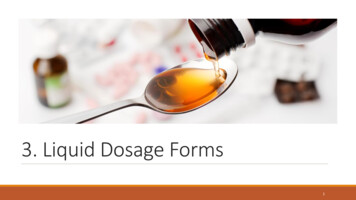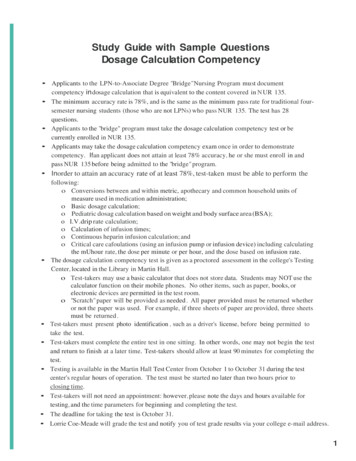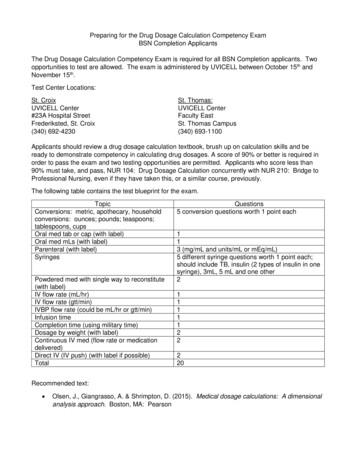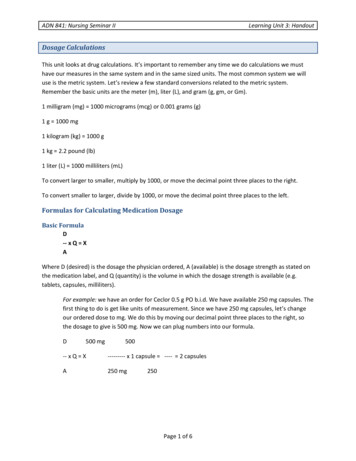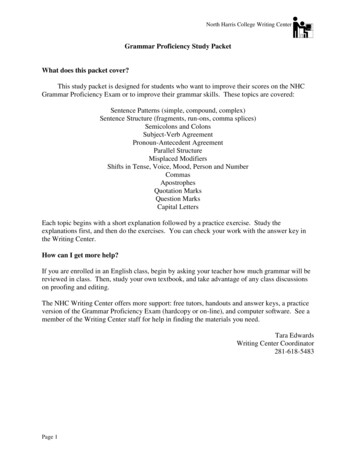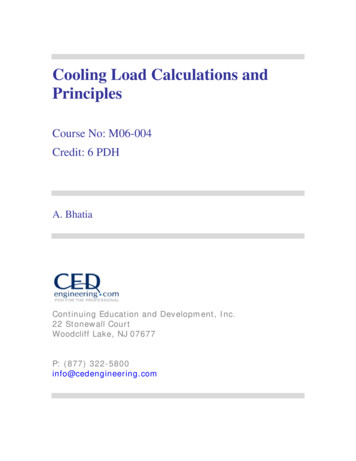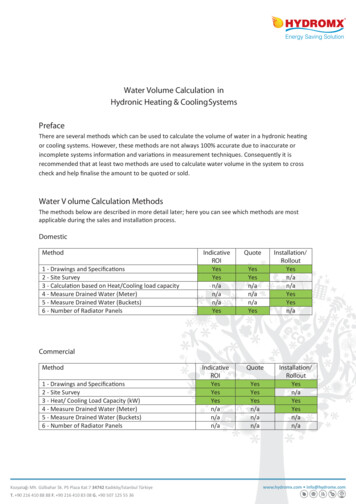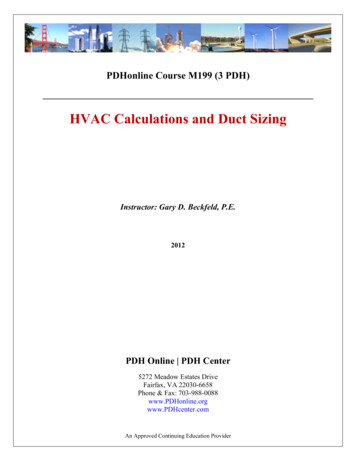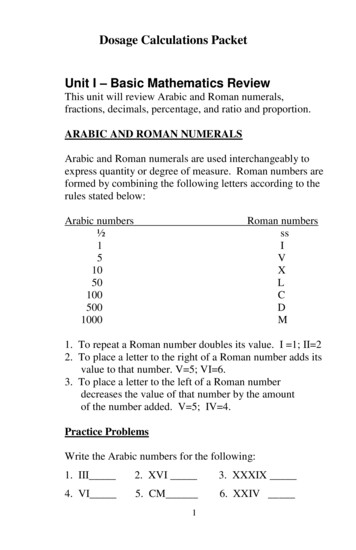
Transcription
Dosage Calculations PacketUnit I – Basic Mathematics ReviewThis unit will review Arabic and Roman numerals,fractions, decimals, percentage, and ratio and proportion.ARABIC AND ROMAN NUMERALSArabic and Roman numerals are used interchangeably toexpress quantity or degree of measure. Roman numbers areformed by combining the following letters according to therules stated below:Arabic numbers½1510501005001000Roman numbersssIVXLCDM1. To repeat a Roman number doubles its value. I 1; II 22. To place a letter to the right of a Roman number adds itsvalue to that number. V 5; VI 6.3. To place a letter to the left of a Roman numberdecreases the value of that number by the amountof the number added. V 5; IV 4.Practice ProblemsWrite the Arabic numbers for the following:1. III2. XVI3. XXXIX4. VI5. CM6. XXIV1
Write the Roman numbers for the following:7.2 8. 14 9. 40 10. 6911. 80 12.150 13. 99 14. 19Answers:1. 32. 163. 397. II8. XIV11. LXXX12. CL4. 69. XL13. IC5. 9006. 2410. LXIX14. XIXFRACTIONSDefinition: A fraction is a part of a whole number. Afraction has 2 parts, the top number is called the numeratorand the bottom number is called the denominator.Example: ½ 1 is the numerator and 2 is the denominator.There are 4 types of fractions:1. Proper fractions – the numerator is less than thedenominator. Example: ½.2. Improper fractions – the numerator is greater than thedenominator. Example: 6/5.3. Complex fractions – the numerator or denominator maybe either a fraction or a whole number.Example: ½ or ½2¾4. Mixed number – there is a whole number and a fractioncombined. Example: 3 ½.2
To change a mixed number to an improper fraction, youmust multiply the whole number by the denominatorand add the numerator. Example: 3 ½ 7/2.Practice ProblemsReduce the following fractions to the lowest terms2/4 3/6 3/9 4/6 10/20 15/20 2/10 3/12 Answers:1. ½2. ½7. 1/38. 1/53. 1/49. ½2/8 8/12 5/10 3/15 4. ½10. 2/35. ¾11. ¼6. 2/312. 1/5Change the following improper fractions to mixed numbers1. 6/4 4. 3/2 Answers:1. 1 ½ 2. 1 2/52. 7/5 5. 7/3 3. 1 7/83. 15/8 6. 11/10 4. 1 ½5. 2 1/36. 1 1/10Change the following mixed numbers to improper fractions1. 3 ½ 2. 6 ½ 4. 33 1/3 5. 8 ¾ Answers:1. 7/2 2. 13/23. 21/24. 100/333. 10 ½ 6. 9 3/5 5. 35/46. 48/5
Adding Fractions With Like Denominators:1. Add the numerators.2. Place the answer over the denominator.3. Reduce the answer to the lowest term by dividing thenumerator and the denominator by the largest numberthat can divide them both.Example: 1/8 1/8 2/8Divide the numerator and denominator by 2 and2/8 becomes ¼.Adding Fractions With Unlike Denominators:1. Determine the smallest number that the denominators ofeach fraction divide into evenly. This is called the leastcommon denominator(LCD).2. Divide the denominator into the LCD and multiply theresults by the numerator.3. Add the new numerators and place over the newdenominator.4. Reduce to lowest terms.Example:1/2 1/3 ( 2 and 3 will divide evenly into 6)6 divided by 2 3 x 1 36 divided by 3 2 x 1 23 2 566 This is reduced to the lowest terms.4
Subtracting Fractions With Like Denominators:1. Subtract the numerators.2. Place the difference over the denominator.3. Reduce to the lowest terms.Example: 7 – 3 48 8 8This reduces to ½.Subtracting Fractions With Unlike Denominators:1.2.3.4.Find the LCD and convert fractions.Subtract the numerators.Place the difference over the LCD.Reduce to the lowest terms.Example: 1 – 1 (Find the LCD) 3 – 2 12 36 6 6This answer is reduced to the lowest terms.Multiplying Fractions:1. Multiply the numerators.2. Multiply the denominators.3. Reduce to the lowest terms.Example: 3 x 2 6 Reduced 14 3 1225
Dividing Fractions:1.2.3.4.5.Invert the divisor (2/3 would become 3/2).Change the division sign to multiplication.Multiply the numerators.Multiply the denominators.Reduce to the lowest terms.Example: 1 divided by 1 1 x 2 2323 13This answer is reduced to the lowest terms.Practice Problems for Fractions:1. 1/4 ¼ 2. 1/3 2/3 3. 2/5 2/5 4. 3/4 ¼ 5. 1/6 3/12 6. ¼ ½ 7. 5/8 ¾ 8. 2/3 3/5 9. 2/3 – 1/3 10. 5/8 – 3/8 11. ¾ - ½ 12. 7/10 –1/20 13. 7/12 – 1/6 14. 7/9 – 1/3 15. 2/3 X 1/8 16. 1/3 X 1/6 17.18.19.20.21.22.23.24.¾X½ 9/25 X 4/32 5/6 X 2/3 ¾ divided by 2/3 1/9 divided by 3/9 1/8 divided by 2/3 1/5 divided by ½ 3/8 divided by 3/8 Answers:1. ½9. 1/317. 3/82. 110. 1/418. 9/2003. 4/511. 1/419. 5/94. 112. 13/2020. 1 1/85. 5/1213. 5/1221. 1/36. ¾14. 4/922. 3/167. 1 3/815. 1/1223. 2/58. 1 4/1516. 1/1824. 1Please see Nursing Faculty if you need further homework.6
DECIMALS:Adding Decimals:Align the decimals and add.Example:0.216.093 12.90134.04153.24Subtracting Decimals:Align the decimals and subtract.Examples:2.56- 0.831.736.00- 0.905.10Multiplying Decimals:1. Multiply as whole numbers.2. Count the number of decimal places in each number.3. Count from right to left in the answer and place thedecimal point.Examples:3.34x 0.82.67212.67x .25633525343.16757
Dividing Decimals:1. Change the dividing number to a whole number bymoving the decimal point to the right.2. Change the number being divided by moving itsdecimal point the same number of places to the right.3. Divide as usual.4. Place the decimal point in the answer directly above thedecimal point in the dividend.5. Carry out the answer to 3 decimal places beforerounding off to 2 places.Example:Example:73.0.03. 2.19.21099081.10.05. 4.05.5400550550The answer is 73The answer is 81.18
Rounding Decimals:1. Determine at what place you are going to round.2. If the number to the right of the place you are goingto round is greater than or equal to 5, round up to thenext number.3. If that number is less than 5, delete the remainingnumber or numbers.Practice Problems1. 2.03 .009 12.9 2. 3.33 0.6 4.00 3. 12.009 - .89 4. 3.90 – 2.02 5. 4.32 X .9 6. 0.980 X 0.2 7. 24 divided by 1.2 8. 0.75 divided by 0.5 Round the decimal to the tenth place:9. 0.75 10. 0.23 11. 0.98 12. 0.36 Round the decimal to the hundredth place:13. 1.086 14. 0.456 15. 12.234 16. 19.014 Answers:1. 14.9392. 7.933. 11.1194. 1.885. 3.8886. 0.1967. 208. 1.59. 0.810. 0.211. 1.012. 0.413. 1.0914. 0.4615. 12.2316. 19.0114. 0.4615. 12.23Please see Nursing Faculty if you need further homework.9
PERCENTAGE:A percentage is a part of 100.Changing Percent to Fractions:1.2.3.4.The numerator will be the number in front of the % sign.The denominator will always be 100.Divide as usual.Reduce to the lowest terms.Example: 25% 25 (25 divided by 100) ¼100Changing Fractions to Percent:1. Divide the numerator by the denominator.2. Multiply the answer by 100.Example: ¼ 1 divided by 4 0.25 X 100 25%Changing Percent to a decimal:1. Remove the % sign.2. Divide by 100 (or move the decimal 2 places to the left).Example: 25% 25 .2510010
Practice Problems:Change to fraction:Change to %:Change to decimal:1. 10% 2. ½ 3. 10% 4. 45% 5. 1/3 6. 45% 7. 75% 8. ¼ 9. 75% 10. 25% 11. 4/5 12. 25% Answers:1. 1/105. 33%9. 0.752. 50%6. 0.4510. ¼3. 0.17. ¾11. 80%4. 9/208. 25%12. 0.25RATIO and PROPORTION:Ratio:Definition: A ratio expresses the relationship of onequantity to another. When solving dosage calculations, aratio is composed of two numbers that are separated by acolon.Examples:2:4 or 4:16 or 1:50Proportion:Definition: A proportion shows the relationshipbetween two ratios that are equal.11
Examples: 1 : 2 :: 2 : 4or2 : 8 :: 5 : 20The first example is read like this: 1 is to 2 as 2 is to 4.You can see that these two ratios are equal. The way todemonstrate this mathematically is to multiply the twoouter numbers together and the two inner numberstogether. The answers will be equal to one another.Example: 2 : 8 :: 5 : 202 x 20 40 (outer numbers multiplied together)8 x 5 40 (inner numbers multiplied together)Ratio and proportions are used to solve dosage calculationproblems when you do not know one of the four numbers.This is called solving for “X” or solving for the unknown.Solving for “X”:1. Multiply the outer numbers.2. Multiply the inner numbers.3. Place the answer that contains the “X” to the left ofthe equals sign and solve the equation by diving theentire equation by the number before the “X”.Example: 3 : 5 :: 15 : X3X 75 (divide the equation by 3)3X 75X 2533To check your work, put the answer into the equation andmultiply the outer numbers and the inner numbers andthey should be equal.Example: 3 : 5 :: 15 : 253 x 25 75 (outer numbers multiplied together)5 x 15 75 (inner numbers multiplied together)12
Practice ProblemsFind the value of x:1. 2 : 3 :: 8 : x2. x : 5000 :: 10 : 5003. 2/3 : ¾ :: x : 21/244. 5 : x :: 20 : 305. 0.125 : 1 :: 0.25 : x6. 2.2 : 6 :: x : 1407. 12 : 6 :: 24 : x8. x : 1/150 :: 1 : 1/100Answers:1. 122. 1003. 7/94. 7 1/25. 26. 51.337. 128. 2/313
Unit II – Systems of Measurement and ConversionNurses have the legal responsibility for administering theappropriate amount of medications. They must be able tointerpret dosage instructions from manufacturers anddoctors to administer doses accurately. They must also beable to provide client education regarding homeadministration. There are three primary systems ofmeasure that are currently used in medicationadministration: the metric system, the apothecary system,and the household system.THE METRIC SYSTEMThe metric system is widely used in dosage calculations. Ituses powers of 10 and the basic units of measure are thegram, liter, and meter. A gram measures weight, a litermeasures fluid, and a meter measures length.Gram:measures weight.Gram may be written G, g, Gm or gm.Liter:measures liquid.Liter may be written L or l14
Meter:measures length. Meter maybe written m.The metric system also uses prefixes to describe how muchof the basic unit:Kilo 1000 times the basic unit.Centi 1/100 of the basic unit or 0.01.Milli 1/1000 of the basic unit or 0.001.Micro 1/1,000,000 of the basic unit or 0.000001.Commonly seen units are the Kg (kilogram), ml (milliliter),and mcg (microgram).The metric system contains the following rules:1. Arabic numbers are used (i.e. 150)2. The symbol of measure is placed after the number(i.e. 150 ml)3. Fractions are written as decimals (0.25)METRIC BASICEQUIVALENTS1 Kg. 1000 Gm.1 Gm. 1000 mg.1 mg. 1000 mcg.1 ml. 1 c.c.1 L. 1000 c.c. or 1000 ml.Practice ProblemsAbbreviate the following metric notations:1. Five grams2. Seven hundred fifty milliliters3. One and one-half kilograms4. Two hundred micrograms5. One- half milligram6. Five-hundredths of a gram7. Six hundred milligrams8. Three-tenths of a gram15
Answers: 1. 5 gm 2. 750 ml3. 1 ½ kg 4. 200 mcg5. 0.5 mg6. 0.05 gm7. 600 mg8. 0.3 gmUsing Ratio and Proportion Within the Metric SystemAs stated earlier, nurses use ratios (1:2) to makecomparisons, and proportions to show that two ratios areequal (1 : 2 :: 2 : 4). This principle is used to exchangeweights within the metric system.RULES OF PROPORTION1.2.3.Example:Units of ratios must correspond within the sameproportion. Correct Gm. : Kg. :: Gm. : Kg.No more than 2 different units of measure can beused within the proportion.Label all numbers with the appropriate unit ofmeasure.0.5 Kg. ? gm.First, find the basic equivalent in the previous chart.This would be, 1 Kg. 1000 Gm. Now you know 3 of the4 numbers in the equation. Solve for “X” as you weretaught in Unit I and utilize the above rules of proportion.Set the problem up: 1 Kg. : 1000 gm. :: 0.5 Kg. : X gmX 500Remember, you multiply the outside numbers and then theinside numbers and then divide. In this example, it was notnecessary to divide.What label comes after 500? Look up at your problem, itwould be 500 gm. The label will always be what followsthe unknown “X”.16
Practice ProblemsSolve for “X”:1. 250 Gm. X Kg.6. 3.5 L. X ml.2. 2500 mcg. X mg.7. 154 c.c. X L.3. 15 mg. X mcg.8. 0.25 L. X ml.4. 4 ml. X c.c.9. 2000 mg. X gm.5. 3 Kg. X Gm.10. 250 mg. X Gm.Answers: 1. 0.25 kg2. 2.5 mg3. 15000 mcg4. 4cc5. 3000gm6. 3500 ml7. 0.154 L8. 250 ml9. 2 gm10. 0.25 gmPlease see Nursing Faculty if you need further homework.THE APOTHECARY SYSTEMThe Apothecary System is another method of expressingunits of measure. It is an old system and is not usedexclusively because it is not standarized. That means thateach measure is an approximate amount, not an exactamount. But, some doctors still order medicines using thissystem, and some labels contain this system as well. It isdifferent from the metric system in the following ways:1. It uses Roman numerals (ss 1/2, i 1, iv 4, v 5,ix 9, x 10)2. The unit is written before the amount (gr i, gr ss, gr iv)3. Fractions are written as common fractions (gr. 1/150).The only exception is ½, which is written as is.The basic units of measure that are commonly used are thegrain, ounce, dram, and minim.17
Grain:written gr.Ounce:a cursivemeasures weight and ismeasures liquid amounts and is written likebut with an extra hump on top Dram:Used to measure smaller amounts ofliquid medicine. It is written just like a cursive .Minim:Tiny amount of liquid medicine. A minimequals a drop. It is written like a cursiveit has a long tail.18and sometimes
Apothecary measures for dry weight are infrequently used.Therefore, the word “fluid” is generally dropped whenreferring to the dram or ounce. The table below reflectsapothecary measures for volume.APOTHECARY BASIC EQUIVALENCES60 minims 1 fluid dram8 fluid drams I fluid ounce16 fluid ounces 1 pint2 pints 1 quart4 quarts 1 gallonPractice ProblemsSolve for “X” using ratio and proportion:1. m. 302. dram iv dram X ounce X3. ounce 32 qt. X4. qt. 2 pt. X5. ounce xvi qt. X6. dram iv m. X7. m. xxx dram X8. 0 ss ounce X9. 15 pt. qt. X10. ounce ss m. XAnswers:1. ½ dram 2. ½ oz3. 1 qt4. 4 pts6. 240 m7. ½ dram 8. 1/16 oz 9. 7.5qt195. ½ qt10. 240 m
HOUSEHOLD MEASUREThe Household Unit of Measure is the most commonlyrecognized by laypeople in America. It includes drops,teaspoons, tablespoons, and cups. Drop is written gtt,teaspoon is written tsp or t., tablespoon is written Tbsp,tbsp or T and cup is written C. This system is notstandardized either, it utilizes approximate measures.HOUSEHOLD EQUIVALENTS60 drops (gtts.)3 teaspoons2 Tablespoons8 ounces 1 teaspoon (t.) 1 Tablespoon (T.) 1 ounce 1 cup (C.)Practice ProblemsSolve for “X” using ratio and proportion:1. 5 T. X t.5. 2 ounce X t.2. 3 c. X ounce6. 24 ounce X c.3. 150 gtts. X t.7. 9T. X ounce4. 4 ounce X T.8. 5 t. X gtts.Answers: 1. 15 t5. 12 t6. 3 c2. 24 oz7. 4 ½ oz3. 2.5 t8. 300 gtts4. 8 TNurses must learn all three units of measure (metric,apothecary and household) because medicines are orderedor labeled using the metric system or apothecary system,and we tell patients how much medicine to take using thehousehold system.20
LEARNING the BASIC EQUIVALENCESIn order to calculate dosage amounts you must firstmemorize these basic equivalences:BASIC EQUIVALENCES COMMONLY USED1 g (gram) 1000 mg (milligrams)1 kg (kilogram) 1000 g1 kg 2.2 lb (pounds)1 L. (liter) 1000 ml (milliters)1 ml 1 cc (cubic centimeter)1 mg 1000 mcg. (micrograms)2 T (tablespoon) 1 oz15 – 16 gtt (drop) 1 ml60 mg gr 1 (grain)1 dram 4 ml30 ml 1 oz (ounce)1 T 3 tsp (teaspoon)1 C (cup) 8 oz1 T 15 ml1 tsp 5 mlConversion Between SystemsNow that you know the equivalences, it is time to learnhow to convert values between systems. Keep your chartsof equivalences handy and refer back to them often.Many times the physician will order a medication in onestrength but the pharmacy stocks the medication in adifferent strength. By using ratio and proportion that youwere taught in Unit I, you can determine how much of themedication that the pharmacy stocks will be needed toequal the amount ordered by the physician.Always set up your problem in the following manner:KNOWN UNIT : KNOWN:: DESIRED UNIT : UNKNOWNOF MEASURE EQUIVALENTOF MEASUREEQUIVALENTUNIT OF(X)MEASURE21
Example: How many grams are there in 500mg?( The known ratio is 1000 mg 1 gm)KNOWN UNIT : KNOWN::OF MEASUREEQUIVALENTUNIT OFMEASURE1000 mg:1 gm::DESIRED : XUNIT OFMEASURE500 mg : X gm1000 X 500X 5001000X 0.5 gm (Remember to check your answer)Example: 20 mg is equal to how many grains?( The known ratio is 60 mg 1 gr)Use the above formula:60 mg : 1gr :: 20 mg : X gr60 X 20X 2060X 1/3 grain (Remember to check your answer)22
Practice Problems1. ¼ gr mg2. 120 mg gm3. 0.05 gm gr4. 55 lbs kg5. 250 mcg mg6. 0.3 ml m7. 4 drams ml8. 45 ml oz9. 1.25 L ml10. 20 ml tsp11. 1 ½ gr gm12. 0.2 mg gr13. 2500 mg gm14. 30 kgs lbs15. 12 oz cc16. 0.003 mcg17. 1000 ml pts18. 165 lbs kg19. 1.5 tsp cc20. 3 gr mg21. 1 1/3 oz tsp22. 0.006 gm mg23. 10 ml tsp24. 3 C ccAnswers:1. 15 mg2. 0.120 gm3. 0.75 gr4. 25 kg5. 0.25 mg6. 5 m7. 16 ml8. 1 ½ oz9. 1250 ml10. 4 tsp11. 0.1 gm12. 1/300 gr13.14.15.16.17.18.19.20.21.22.23.24.2.5 gm66 lbs360 cc3 mcg2 pts75 kg7.5 cc180 mg8 tsp6 mg2 tsp240 cPlease see Nursing Faculty for further homework.23
UNIT III – Simple Dosage CalculationsThe focus of this unit is learning to interpret physicianorders and read medication labels correctly. In addition,the administration of safe dosages of oral and parenteralmedication will be discussed.INTERPRETING PHYSICIAN ORDERSIn order to administer medications safely and correctly thenurse must first be able to interpret the physicians order.Example: Ambien 10 mg p.o. q h.s. p.r.n. sleep.What is the name of the medication? AmbienWhat is the prescribed dosage? 10 mgWhat is the route of administration? p.o. (by mouth)When is the drug to be administered? h.s. (hr of sleep)Why is the drug to be administered? to help pt sleepPractice ProblemsFor each of the MD orders interpret the following:a.b.c.d.e.Medication name?Prescribed dosage?Route of administration?Time of administration?What other directions, if any, are given?1.2.3.4.K-Lor 20 mEq p.o. in 120 cc orange juice b.i.d.Valium 5 mg p.o. q 4 hr p.r.n. anxiety.Tylenol gr X p.o. q 4 hr p.r.n. temp 101.Demerol 75 mg I.M. q 4 hr p.r.n. pain.24
Answers:1. a. K-Lorb. 20 mEqc. po (by mouth)d. 2 times a daye. mix in 120 cc orange juice2. a.b.c.d.e.Valium5 mgpoevery 4 hours as neededgive as needed for anxiety3. a.b.c.d.e.Tylenolgrain 10poevery 4 hours as neededgive if temp 1014. a.b.c.d.e.Demerol75 mgIM (intramuscular)every 4 hours as neededgive as needed for painINTERPRETING MEDICATION LABELSMedication label information varies from one medication toanother. However, most all labels contain the followinginformation; brand name, generic name, dosage, route ofadministration and manufacturer. If a medication has to bereconstituted, the label will contain information regardingsuitable diluents, amount of diluents to be added,concentration of medication after it is reconstituted and itsstability. The label of a medication to be administered IVshould tell what IV fluids are compatible with themedication. If the medication is in a multi-dose package itwill give the total amount of the medication contained.25
Practice ProblemsIdentify the following for each of the medication labels:a. Generic namec. Route of administration or formb. Trade named. Dosage1.2.3.4.Answers:1. a. ramipril2. a. cefotaxime3. a. phenobarbital4. a. epoetin alfab. Altaceb. Claforanb. noneb. Epogen26c. capsulesc. IM/IVc. tabletsc. 1 ml viald. 2.5 mg/capd. 1 gmd. 15 mg/tabd. 3,000 u/ml
CALCULATION OF ORAL DOSAGESOral dosage forms of medications include tablets, capsules,suspensions, lozenges, powders, emulsions, solutions,tinctures, syrups and elixirs. The liquid forms of oralmedications are generally calculated to be administered inmillimeters, cubic centimeters teaspoons, table
1 Dosage Calculations Packet Unit I – Basic Mathematics Review This unit will review Arabic and Roman numerals, f


